Since I was a young child Mars held a special fascination for me. It was so close and yet so faraway. I have never doubted that it once had advanced life and still has remnants of that life now. I am a dedicated member of the Mars Society,Norcal Mars Society National Space Society, Planetary Society, And the SETI Institute. I am a supporter of Explore Mars, Inc. I'm a great admirer of Elon Musk and SpaceX. I have a strong feeling that Space X will send a human to Mars first.
Sunday, October 30, 2016
Friday, October 28, 2016
Why Explore Mars-A Ten-Part Series
http://www.huffingtonpost.com/entry/why-mars-an-introduction_us_57fd0308e4b0b6a430359446?nr23n6vqbys2hdunmi&utm_source=Explore+Mars+Newsletter&utm_campaign=6c63cc0375-Sept_v_4&utm_medium=email&utm_term=0_c4f9e110c3-6c63cc0375-35095881
We Should Explore Mars So That Our Students Can Continue To Dream Big
http://www.huffingtonpost.com/entry/explore-mars-students_us_57fd0308e4b0b6a430359448?ng7dwzh89rgujtt9&utm_source=Explore+Mars+Newsletter&utm_campaign=6c63cc0375-Sept_v_4&utm_medium=email&utm_term=0_c4f9e110c3-6c63cc0375-35095881
Why Study Mars-To Better Understand Earth
http://www.huffingtonpost.com/entry/why-study-mars-to-better-understand-the-earth_us_580640ace4b0dd54ce354004?cdcgkyxa708gp66r&utm_source=Explore+Mars+Newsletter&utm_campaign=407a5c2670-Sept_v_4&utm_medium=email&utm_term=0_c4f9e110c3-407a5c2670-35095881
The Mars Generation: Why We Must Go To Mars
http://www.huffingtonpost.com/entry/the-mars-generation-why-we-must-go-to-mars_us_580fb785e4b08582f88c726e?ynfuu2zugxx14te29&utm_source=Explore+Mars+Newsletter&utm_campaign=c4be753c55-Sept_v_4&utm_medium=email&utm_term=0_c4f9e110c3-c4be753c55-30672389
Thursday, October 27, 2016
Further Clues To Lost ESA Mars Probe
http://www.jpl.nasa.gov/news/news.php?feature=6663&utm_source=iContact&utm_medium=email&utm_campaign=NASAJPL&utm_content=daily20161027-4
No Balloons for JPL's Birthday, Just a 'Satelloon'
No Balloons for JPL's Birthday, Just a 'Satelloon': 80 years of daring to do what few others have tried, including bouncing radio signals off a giant, orbiting balloon in 1960.
Tuesday, October 25, 2016
Saturday, October 22, 2016
Exo Mars Schiaparelli Analysis To Continue

ExoMars: Schiaparelli Analysis to Continue
Posted by Ruth McAvinia
2016/10/20 17:05 UTC
Topics: mission status, ExoMars TGO
The fate of the ExoMars lander, Schiaparelli, remains uncertain. European Space Agency mission controllers had been optimistic on Wednesday night that a definitive answer would be known by Thursday morning’s news briefing (watch it here). However, although some more details have been made public about the lander’s descent, it is not yet clear whether it hit the martian surface at a speed it could not survive.
The entry, descent, and landing sequence was fully automated and should have consisted of clear phases. As it reached the atmosphere of Mars, the lander would slow down with atmospheric drag and heat up through friction, before opening a parachute, later jettisoning its heat shield, jettisoning the back half of the protective aeroshell along with the parachute, and firing thrusters shortly in advance of touchdown. The parachute and aeroshell should have been released at 1.2 kilometers from the surface, followed one second later by the activation of the thrusters bringing the lander down to around two meters before a final drop to the surface. The data suggest that the heatshield performed well. The parachute phase happened, and the thrusters fired at least briefly, but possibly not at the intended time or altitude.
Investigations are continuing into exactly what happened and at what stage of the flight. ESA has emphasized the experimental nature of the lander, and the benefits of the data already collected. The detailed monitoring of the descent was a lesson learned from the loss of the UK’s Beagle 2 lander in 2003, whose fate was unknown until 2015. All of the data transmitted by Schiaparelli, also known as the entry, descent and landing demonstrator module (EDM), during descent has been recovered, and the Mars Reconnaissance Orbiter may add some more information about its fate, although MRO has not been in contact with the lander.
Andrea Accomazzo, ESA’s head of solar and planetary missions said: “The EDM entered the atmosphere of Mars and most important of all we have collected all the engineering information from this phase. This we have successfully done with the Trace Gas Orbiter.
“We have data from all the hardware of the EDM. This is fundamental for a test. We can also see the hardware has provided meaningful data. Now we need to analyse why, when we put together this data in the martian environment, the spacecraft did not behave exactly as we expected. It will take more time to have a global picture of the descent.”
Don McCoy, ExoMars project manager, said that the AMELIA (Atmospheric Mars Entry and Landing Investigation and Analysis) instrument team believed most of their data were collected. AMELIA co-principal investigator Stephen Lewis tweeted that 600MB of Schiaparelli data had been received and that 99% of the test was complete.
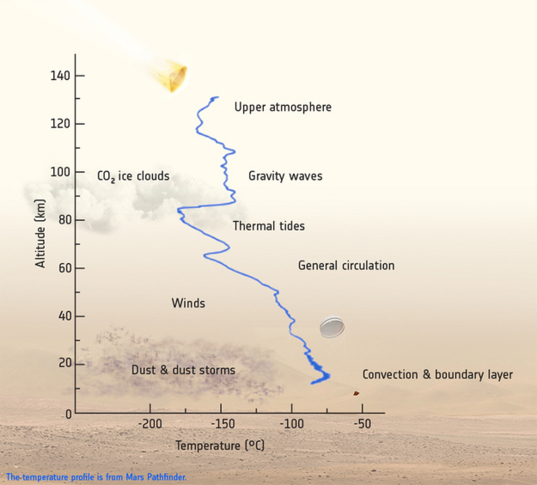
ESA / NASA
Science with AMELIA
The Schiaparelli Entry, descent and landing Demonstrator Module (EDM) carried a number of sensors to measure characteristics of the atmosphere during atmospheric entry and descent. The AMELIA (Atmospheric Mars Entry and Landing Investigation and Analysis) programme, to be carried out by the Schiaparelli science team, will use the engineering data from these sensors to reconstruct the module's trajectory and determine atmospheric conditions, such as density and wind, from a high altitude to the surface. These measurements are key to improving models of the Martian atmosphere. In this illustration, a temperature profile of the Martian atmosphere obtained by the NASA Mars Pathfinder probe is shown.
ESA Director General Jan Wörner again emphasized the value of the information gained by the lander, and the success of the Trace Gas Orbiter (TGO).
TGO continues to perform well following its orbit insertion manoeuvre on Wednesday. It will have a challenging aerobraking phase next year to change its orbit. In addition to conducting science around Mars, TGO will serve as a relay station for ExoMars 2020.
Other related posts:
Or read more blog entries about: mission status, ExoMars TGO
In This Section
Blog Search
Essential Advocacy
Our Advocacy Program provides each Society member a voice in the process.
Funding is critical. The more we have, the more effective we can be, translating into more missions, more science, and more exploration.
Camera on Mars Orbiter Shows Signs of Latest Mars Lander
Camera on Mars Orbiter Shows Signs of Latest Mars Lander: NASA's Mars Reconnaissance Orbiter has identified new markings on the surface of the Red Planet that are believed to be related to Europe's Schiaparelli test lander, which arrived at Mars on Oct. 19.
Juno Sends Back Some Stunning Pictures Of Jupiter
Juno Sends Back Closest-Ever Images of Jupiter “Like Nothing We Have Seen Before”

Image courtesy NASA
NASA recently uploaded the most detailed and exceptional images of Jupiter ever taken, saying these closest-ever images of Jupiter are “like nothing we have seen before.”
The Juno spacecraft, which entered Jupiter’s orbit in July after a five-year trek across the solar system, captured all these images. Juno got closer to Jupiter than any other spacecraft in history and took exclusive images of the planet from this historic 6-hour flyby.
NASA took 1.5 days to download these images. The images show previously unseen storm systems and weather activity, as well as Jupiter’s north pole.
The principal investigator of the Juno mission, Scott Bolton, said, “the first glimpse of Jupiter’s north pole, and it looks like nothing we have seen or imagined before.”
“It’s bluer in color up there than other parts of the planet, and there are a lot of storms.”
An infrared device, the Italian Space Agency’s Jovian Infrared Auroral Mapper (JIRAM), helped the Juno team study Jupiter’s polar regions in infrared wavelengths.
Bolton added, “There is no sign of the latitudinal bands or zone and belts that we are used to – this image is hardly recognizable as Jupiter. We’re seeing signs that the clouds have shadows, possibly indicating that the clouds are at a higher altitude than other features.”
 |
Click here to Reply or Forward
|
Friday, October 21, 2016
Dr. Robert Zubrin Writes A Critique Of The Space-X Interplanetary Transport System
|
Subscribe to:
Comments (Atom)
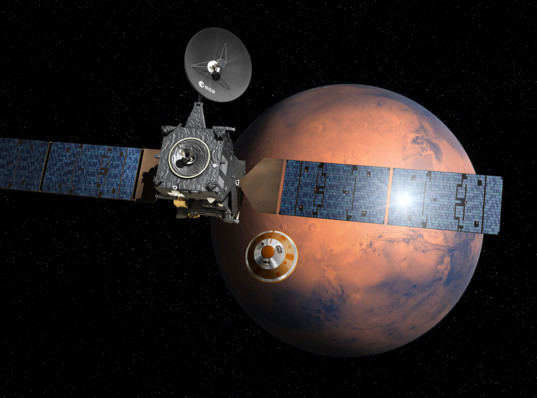



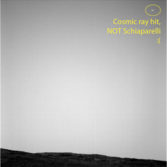
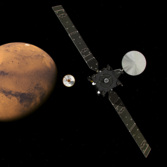






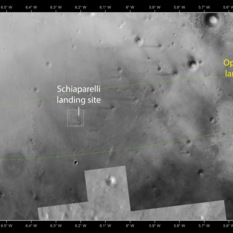











The MRO made a pass and there's literally a black smear on Mars now, so sadly it appears the Beagle 2 landed intact but unable to communicate whereas Schiaparelli communicated until impact.